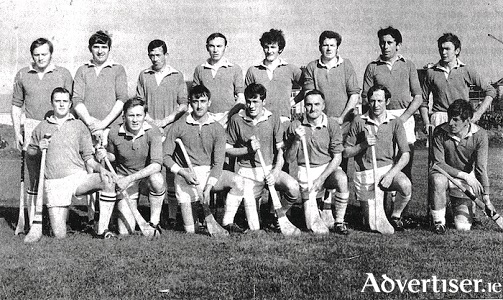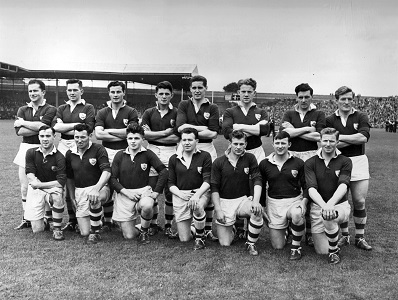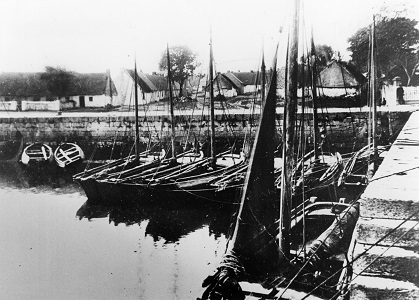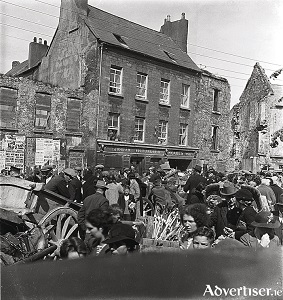Old Galway
WILL GALWAY BEAT MAYO?

by Tom Kenny
The rivalry between Galway and Mayo is as old as the provincial championship itself. The Connacht GAA Council was actually founded on the same day that Galway and Mayo contested the first ‘official’ Connacht senior football final. That game was played in Claremorris in November 1902 and was won by Mayo. Galway played “with the wind and the incline” in the first half while the vast crowd agreed to ‘keep strictly outside the field of play’, something the organisers clearly regarded as an unexpected bonus.
Liam Mellows, county champions

by Tom Kenny
We know that hurling was played in the Bohermore area 200 years ago. Several different clubs operated around there at different times — Galway City, Bohermore 98s, College Road, Thomas Ashe, etc. Players would occasionally transfer from one club to another so it was natural for them to join the new club that was formed on February 11, 1933. The club was called Liam Mellows after the patriot who led the 1916 rebellion in Galway.
THE NAILER’ FORGE

by Tom Kenny
The Connaught Journal of July 1823 reported that Michael Walsh, the Nailer of Bridge Street was in great distress. He was described as being very poor, and though he worked hard, his life had been a struggle for some 12 years now because of a ‘disease of his leg’. The unfortunate man had to have the leg amputated and was now ‘reduced to extreme want’ as he was unable to work. The newspaper highlighted his predicament and hoped that the charitable and humane people of Galway would contribute to his support while he was recovering from the operation. So we know that the nailer was in business there some 200 years ago.
Remembering Tom McHugh

by Tom Kenny
This is the Galway football team that played Tyrone in the 1956 All-Ireland semi-final in Croke Park. They are, back row, left to right; Seán Purcell, Gerry Kirwan, Joe Young, Jack Kissane, Frank Evers, Mattie McDonagh, Tom McHugh, Billy O’Neill. In front are, Mick Greally, Tom ‘Pook’ Dillon, Sean Keely, Jack Mangan, Frank Stockwell, Jack Mahon and Gerry Daly. The first score in the game was a brilliant point by Galway’s Tom McHugh. Galway won a thrilling close game that featured a high degree of sportsmanship, and went on to beat Cork in the final.
SINKING OF THE NEPTUNE

by Tom Kenny
This photograph was taken about 100 years ago and shows several boats from the Claddagh fleet moored at the quayside.
The fishing trawler Neptune was one of the finest boats in the fleet. It was a 40 – 50 ton trawler, bigger than most of the other boats and was owned by Martin Ashe. On Monday morning, December 17th, 1917, the boat left Galway with four men and a boy on board. They were Martin McDonagh from Buttermilk Lane, aged 60 and married; William Walsh, Quay Street, aged 40 and married. Captain; his son Patrick, aged 16; Bartley Gill, Quay Street, aged 50 and married; Stephen Melia of Church Lane, aged 33 and single. Before they left, the skipper, Henry Connell had refused to take the boat out. He was an experienced merchant sailor who had returned from the Great War and he felt there was some problem with the boat. His decision was for a number of years afterwards criticised by a family member of one of the deceased.
THE SWEETS OF OUR CHILDHOOD

by Tom Kenny
A sweet is defined as having a taste of sugar or honey. It is not bitter or sour, but is pleasingly fragrant and agreeable. It is strange that while the taste never lingers too long, the memory of that taste can stay with you for life, particularly if it was one of the favourite sweets of your childhood. The sweet shops of yesteryear had a special smell, an aroma of temptation which you got as you went through the door. Even to look in the shop window was to make an imaginative journey of the various tastes that were on display.
HUMBLE WORKS FOR HUMBLE PEOPLE

by Tom Kenny
Our illustration today is of the inner part of Galway Bay and shows the piers and harbours therein. It is one of the images in a new book entitled Humble Works for Humble People written by Noel Wilkins. Noel is a retired professor of zoology who has a number of titles to his name already, many of them dealing with County Galway. This book explores the history of the fishery piers and harbours of County Galway and north Clare. It is a scholarly but eminently readable testament to these piers as feats of engineering but it also gives us a wonderful account of the human aspect that shadowed their construction and finally it describes beautifully the maritime activities that gave life to the west coast – kelp making, fishing, turf distribution and sea-borne trade.
A Galway Tradition

by Tom Kenny
In Hely Dutton’s Survey of Galway in 1824, he reported; “The vegetable market near the Main Guard is generally well supplied, and at reasonable rates; all kinds come to the market washed, by which any imperfection is easily detected. The cabbage raised near the sea on seaweed is particularly delicious; those who have been used to those cultivated on ground highly manured cannot form any idea of the difference. There are also, in season, peaches, strawberries, gooseberries, apples, pears etc.”
